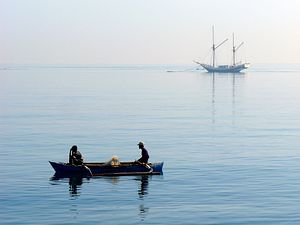On March 6, 2018, Australia and Timor-Leste signed a landmark treaty that draws permanent maritime boundaries in the Timor Sea. The treaty is the result of the United Nations Compulsory Conciliation (UNCC) processes that have facilitated negotiations between the two states for over a year. This represents an important symbolic victory for Timor-Leste, as Australia had been reluctant to establish permanent maritime boundaries.
This does not mean that the Timor Sea saga is over. Maritime boundaries are only one aspect in this complex set of disputes. It’s still to be determined whether gas from the Greater Sunrise complex of gas fields in the Sea is piped to Timor-Leste or Australia for processing, and this decision will, in turn, dictate the revenue split.
The new treaty provides two options for the development of Greater Sunrise with a different split in revenues depending on which direction the pipeline runs. If the pipeline goes to Timor-Leste, Australia will receive 30 percent of the upstream revenue arising from the development. Should the gas be pumped to Darwin, Australia will get only 20 percent of the upstream revenue. This “extra” 10 percent of upstream revenue that Timor-Leste would receive if it loses the pipeline has been estimated to be worth US$3.1–3.5 billion.
The timely development of Greater Sunrise is a crucial strategic consideration for Timor-Leste. More than 90 percent of Timor-Leste’s national budget comes from oil revenues from fields that will be depleted in less than five years, and the government will exhaust Timor-Leste’s sovereign wealth fund within a decade at its present rate of expenditure. If Timor-Leste secures the pipeline, it will receive less upstream revenue but instead will gain lucrative downstream industrial and job-creation developments that necessarily flow from the processing of gas and other resources.
But Timor-Leste’s leaders will have to confront unpalatable commercial realities about their pipeline dream.
Independent oil and gas industry experts have argued that the pipeline to Australia is the only option that makes commercial sense. It would take advantage of existing pipelines that connect mature oil fields to their associated onshore processing facilities in Australia, and it would avoid the technical and financial challenges of constructing a pipeline that traverses the Timor Trough. Additionally, a pipeline to Australia would mean that Greater Sunrise commercial venture partners could avoid the risks associated with building new processing facilities in a developing country such as Timor-Leste.
Timor-Leste’s proposal could only occur with a direct subsidy of $5.6 billion by the government of Timor-Leste (or another funder), and it would only provide a mere 7 percent return on a capital investment of $15.6 billion. There is next to no evidence on the public record showing the economic viability of the pipeline to Timor-Leste, nor is there a cost-benefit analysis clearly demonstrating the economic benefits of the planned processing plant for Timorese citizens.
Despite this, Timor-Leste’s politicians have invested significant political capital in not only “winning” the boundary dispute but also in bringing the pipeline to Timor-Leste’s shores and thus securing investment, industry, jobs, and development. In particular, Timor-Leste’s main negotiator and former prime minister, Xanana Gusmao, has been explicit in stating that having the pipeline go to Timor-Leste is non-negotiable. This rhetoric has been used by successive governments since Gusmao first became prime minister in 2007. The pursuit of maritime boundaries (reinvigorated in 2012) was largely driven by the fact that Timor-Leste failed to persuade Woodside Petroleum and the other commercial partners that its pipeline plan was viable.
Timor-Leste’s political situation is currently uncertain as it goes back to the polls in May following the failure of 2017 elections to enable the formation of an authoritative government. During this interregnum, the pipeline has again become a totemic issue in politics. This may ultimately constitute a rhetorical trap: given commercial realities, Timor-Leste’s leadership risks hemming themselves into a corner by being unable to compromise on the pipeline. If the pipeline really is a non-negotiable issue, this is likely to have significant impacts on the future development capacities of the Timorese state.
Timor-Leste appears to be finding its discussions with commercial partners far tougher than those with Australia. While Australia was motivated to reach a settlement with Timor-Leste by the desire to remove a persistent irritant in bilateral relations (as well as to remove a source of censure for Australia on the international stage), the commercial partners are not subject to the same pressures. Timor-Leste may find that Woodside’s priorities do not readily align with Timorese desires — particularly concerning the direction of the pipeline and the rapidity of development.
Against this backdrop, the question is whether the 10 percent “compensation” for the pipeline heading to Australia will be enough to persuade a change of heart in Dili. This would provide the best chance for Timor-Leste to seize the opportunity for developing Greater Sunrise in the near term. Otherwise, the chance to secure Timor-Leste’s economic future through the Timor Gap will disappear.
Clive Schofield is Professor and Director of Research at the Australian Centre for Ocean Resource and Security, University of Wollongong. He tweets from @ProfCliveSchof.
Bec Strating is Lecturer at the Department of Politics and Philosophy at La Trobe University, Melbourne. She tweets from @becstrating. This piece originally appeared at East Asia Forum here, and is republished with kind permission.

































